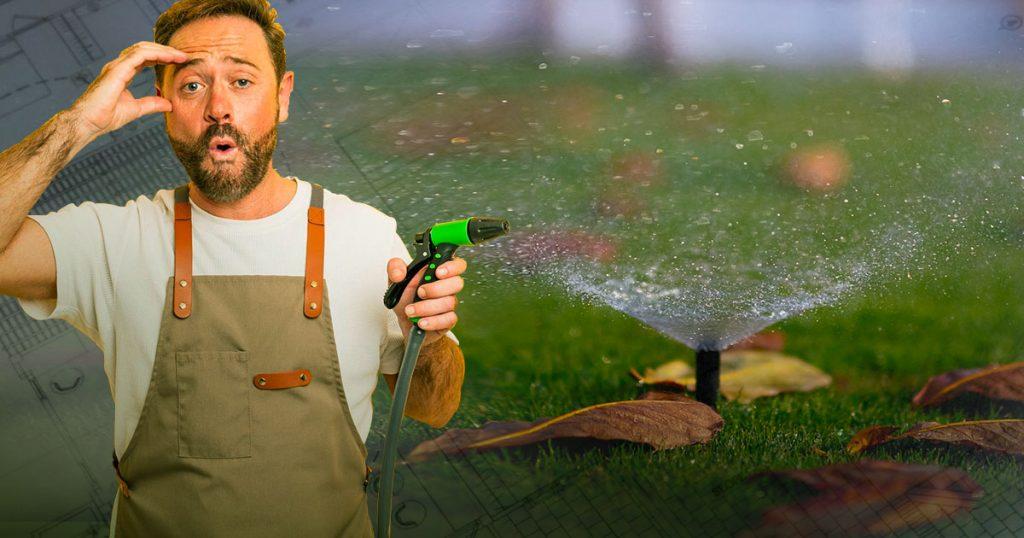Learning how to design a sprinkler system requires some serious knowledge. You’ve got to understand the basics of physics, design principles, and how water flows to get it right. There are six key steps to consider before you begin to design an irrigation system. These steps are essential for a successful setup.
Prepare the area for the system
To start setting up your sprinkler system, gather basic tools like graph paper, a pencil, and a tape measure. Measure the length and width of your property, then draw it to scale on the graph paper. Include everything on your property, like trees, bushes, and buildings. Don’t forget to mark any barriers, like walkways, driveways, and your house outline. This drawing will help you plan where to place your sprinklers.
Know your water supply
Before you start planning your sprinkler system activity, you need to find out some important facts about your property’s water supply. First, call your local water authority and ask for a report on your property’s water flow. You will learn a lot from this study about the water flow that is available for your irrigation system.
Also, it’s a good idea to check how strongly the water flows in different parts of your house. It might be different in each area. You can find out with a quick test using a water gauge:
- Turn off all the water sources inside your home.
- Attach the water gauge to an outdoor spigot.
- Turn on the outdoor spigot to its maximum flow rate to measure the water pressure.
First, you need to know the water pressure available for outdoor use. Then, find out your gallons per minute (GPM) flow rate. To do this, put a one-gallon bucket under the outdoor spigot and turn it on full blast. Time how long it takes to fill the bucket, then divide that time (in seconds) by 60 to get your GPM. These measurements are important for designing and installing your sprinkler system properly, considering your property’s water supply.
Identify your property’s hydrozones
Making sure your plants get just the right amount of water is essential for them to stay healthy and grow well. That’s why you must plan your garden so that plants with similar water needs are grouped together. We call these groups “hydrozones.” There are four main things to consider when setting up hydrozones:
- Area Size and Shape: Hydrozones come in different sizes and shapes, like areas alongside your house, in the front yard, or even small grassy strips along sidewalks. They cover all parts of your landscaping, from grass to ground cover in the backyard.
- Sunlight and Water: Different areas of your property receive varying amounts of sunlight, which affects their water needs. Shaded areas typically require less water compared to those exposed to full sun throughout the day.
- Types of Plants: Plants have diverse water requirements. For instance, lawns often demand significant amounts of water, while native plants are more drought-tolerant. Grouping plants together based on their water needs helps ensure efficient watering practices.
- Soil Type: The type of soil you have affects how well it holds onto water. Clay soil holds water nicely, loamy soil is great because it keeps moisture but also drains well, and sandy soil doesn’t hold water as well and drains fast. Knowing your soil type helps you choose the right sprinkler heads and rotors to make sure all your plants get enough water.
Choose your sprinkler heads
Stick to using one brand of sprinkler system to ensure compatibility and optimal performance. Mixing brands can lead to inconsistencies, as not all sprinkler systems are built the same way. Additionally, consider the specific watering needs of each hydrozone in your landscape:
- Rotors: Select rotor heads based on the distance they need to cover. It’s important to use the same rotor size and spray type within each hydrozone to maintain uniform watering.
- Fixed Sprays: These have a set radius, typically between 6 and 18 feet, and distribute water consistently within their designated area. Ensure that each spray’s coverage overlaps slightly with the next to achieve even watering.
- Spray Heads with Rotary Nozzles: These spray heads deliver water consistently within a radius of 13 to 30 feet.
- Specialty Patterns and Bubblers: Designed for specific landscape challenges, such as narrow strips or targeted watering for trees and shrubs. Spray nozzles cover areas up to five feet wide and 15 feet long, while bubblers provide focused watering for individual plants.
- Micro- or Drip Irrigation: Ideal for ground covers, landscape beds, and planted areas, these systems use small emitters to deliver water directly to plant roots, promoting efficient water usage.
Design the sprinkler’s layout and measure and layout piping
When sketching your plan, mark where you’ll spray water and where sprinkler heads go on your map. Make sure every part of your lawn gets enough water. Clearly show where each nozzle covers to make sure no area is missed, and your whole lawn gets watered properly.
Finishing the plan
Make a list of all the stuff you need to build your sprinkler system, like pipes, fittings, controllers, valves, sprinkler heads, and manifolds. Listing everything helps make sure you don’t forget anything important and makes putting it all together easier.
Successfully Set Up Your DIY Sprinkler System
Making a sprinkler system needs careful planning. Think about water supply, hydrozones, and picking the right sprinkler heads. Follow these steps and plan well to water your lawn and plants effectively for good growth. Gather info, draw your plan, and make a checklist of what you need. With good preparation, you can set up a great sprinkler system for your property.
